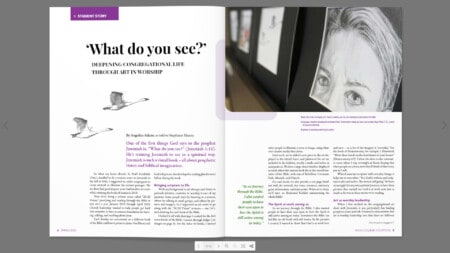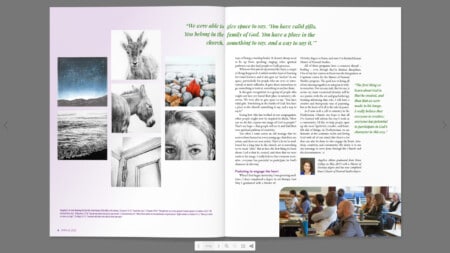‘What do you see?’: Deepening congregational life through art in worship
This article appears in Vocations magazine (pictured at right), Spring 2020. Read this article in the magazine online or download the PDF. To subscribe, click here.
By Angelica Atkins, as told to Stephanie Hanna
One of the first things God says to the prophet Jeremiah is, “What do you see?” (Jeremiah 1:11). He’s training Jeremiah to see in a spiritual way. Jeremiah is such a visual book – all about prophetic vision and biblical imagination. So when my home church, St. Paul’s Leaskdale (Ont.), decided to do a sermon series on Jeremiah in the fall of 2016, I suggested we enlist congregants to create artwork to illustrate the sermon passages. The art show had great impact, so we had another art series while studying the book of Joshua in 2018.
Now we’re doing a sermon series called “20/20 Vision,” preaching and reading through the Bible in just over a year, January 2019 through April 2020. Church leadership wanted to help people get back into scripture, to have a common foundation for learning, talking, and teaching about Jesus.
Each Sunday, we concentrate on a different book of the Bible and how it points to Jesus. Our library and leadership team also developed a reading plan for us to follow during the wee k.
k.
Bringing scripture to life
With my background in art therapy and future in pastoral ministry, creativity in worship is one of my passions. Some people learn by listening to a sermon, others by talking in small groups, and others by pictures and imagery. So I organized an art series to go along with the “20/20 Vision” sermons – one 5×5-inch drawing for each book of the Bible.
I kicked it off with drawings I created for the first seven books of the Bible, Genesis through Judges (see images on page 6). For the other 59 books, I invited other people to illustrate a verse or image, using whatever creative media they chose.
Each week, we’ve added a new piece to the art displayed in the church foyer, and photos of the art are included in the bulletin, weekly e-mails, and online at saintpauls.ca. We have a large visual timeline displayed to track where the current book fits in the overall narrative of the Bible, with eras of Rebellion, Covenant, Exile, Messiah, and Church.
For each book, we also provide a one-page handout with the artwork, key verse, resources, summary, genre information, and main point. When we’re done, we’ll have an illustrated booklet summarizing the whole Bible!
The Spirit at work among us
As we journey through the Bible, I also wanted people to have their eyes open to how the Spirit is still active among us today. Sometimes the Bible can feel like an old book with old stories. In the pictures I created, I wanted to show that God is at work here and now – so a lot of the imagery is “everyday.” For the book of Deuteronomy, for example, I illustrated, “Write these words on the doorframes of your houses” (Deuteronomy 6:9). I drew the door in the commuter room where I stay overnight at Knox, hoping that when people see a door, now they’ll think of that verse, just as I will.
When I associate scripture with everyday things, it helps me to remember, “Yes, God is with us, and scripture is alive and active. The story is still going.” It’s been meaningful for my own spiritual journey, to have these pictures that remind me God is at work now just as much as he was in these stories we’re reading.
Art as worship leadership
When I first worked on the congregational art show with Jeremiah, it was particularly fun finding people to create artwork. I wanted to demonstrate that art is worship leadership, too, that there are different ways of being a worship leader. It doesn’t always need to be up front, speaking, singing; other spiritual pathways can also lead people to God’s presence.
When we first put art up around the foyer, a couple of things happened: it added another layer of learning for visual learners; and it also gave an “anchor” in our space, particularly for people who are new, or introverted, or more reflective. It gave them somewhere to go, something to look at, something to anchor them.
It also gave recognition to a group of people who might not have yet found their place in ministry otherwise. We were able to give space to say, “You have valid gifts. You belong in the family of God. You have a place in the church, something to say, and a way to say it.”
Seeing how this has worked in our congregation, other people might now be inspired to think, “How can we do this, express our image of God to people?” That’s my hope – that people will see it and find their own spiritual pathway of creativity.
Too often I come across an old message that we seem to have learned at a very young age: that there are artists, and there are non-artists. That’s a lie we’ve swallowed for a long time in the church; art is something we’ve made “elite.” But in fact, the first thing we learn about God is that he created, and then that we were made in his image. I really believe that everyone is creative; everyone has potential to participate in God’s character in this way.
Pastoring to engage the heart
When I first began university, I was pursuing medicine; I then completed a degree in art therapy. Last May I graduated with a Master of Divinity degree at Knox, and now I’ve finished Knox’s Master of Pastoral Studies.
All of these programs have a common thread – healing – even though they’re distinct disciplines. One of my last courses at Knox was the Integration or Capstone course for the Master of Pastoral Studies program. The goal was to bring all of our training together, to integrate it within ourselves. Not an easy task. But for me, it seems my main vocational identity will be as a pastor, with the art and psychotherapy training informing that role. I will have a creative and therapeutic way of pastoring, but at the heart of it all is the role of pastor.
As I now seek a call to ministry in the Presbyterian Church, my hope is that all I’ve learned will inform the way I work in a community. I’d like to help people open up the more Spirit-led, creative, and heart-felt side of things. As Presbyterians, we are fantastic at the academic realm and loving God with all of our mind, but there’s a lot that can also be done to also engage the heart, intuition, creativity, and community. My desire is to use my learnings to serve Jesus through the Church and the denomination.
Angelica Atkins graduated from Knox College in May 2019 with a Master of Divinity degree and has now completed Knox’s Master of Pastoral Studies degree.
This article appears in Vocations magazine, Spring 2020. Read this article in the magazine online or download the PDF. To subscribe, click here.
